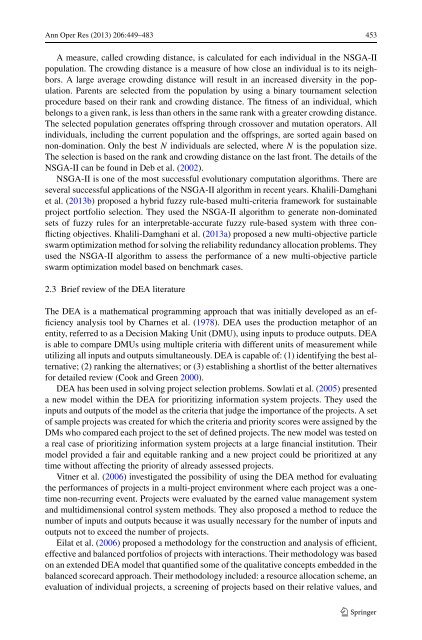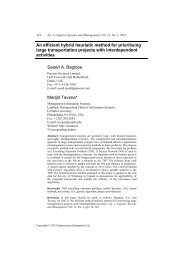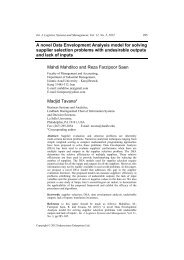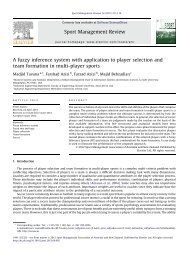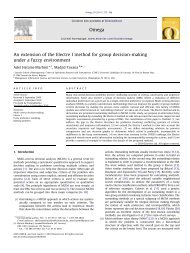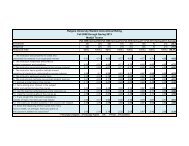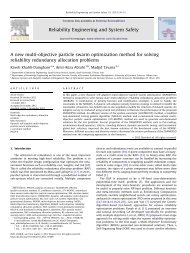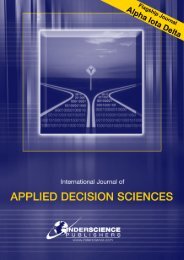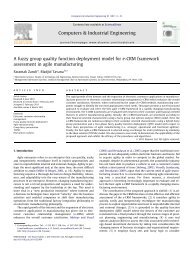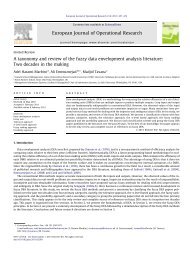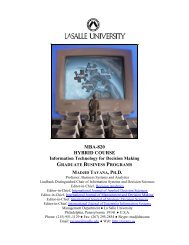A Fuzzy Multidimensional Multiple-Choice Knapsack - Dr. Madjid ...
A Fuzzy Multidimensional Multiple-Choice Knapsack - Dr. Madjid ...
A Fuzzy Multidimensional Multiple-Choice Knapsack - Dr. Madjid ...
Create successful ePaper yourself
Turn your PDF publications into a flip-book with our unique Google optimized e-Paper software.
Ann Oper Res (2013) 206:449–483 453A measure, called crowding distance, is calculated for each individual in the NSGA-IIpopulation. The crowding distance is a measure of how close an individual is to its neighbors.A large average crowding distance will result in an increased diversity in the population.Parents are selected from the population by using a binary tournament selectionprocedure based on their rank and crowding distance. The fitness of an individual, whichbelongs to a given rank, is less than others in the same rank with a greater crowding distance.The selected population generates offspring through crossover and mutation operators. Allindividuals, including the current population and the offsprings, are sorted again based onnon-domination. Only the best N individuals are selected, where N is the population size.The selection is based on the rank and crowding distance on the last front. The details of theNSGA-II can be found in Deb et al. (2002).NSGA-II is one of the most successful evolutionary computation algorithms. There areseveral successful applications of the NSGA-II algorithm in recent years. Khalili-Damghaniet al. (2013b) proposed a hybrid fuzzy rule-based multi-criteria framework for sustainableproject portfolio selection. They used the NSGA-II algorithm to generate non-dominatedsets of fuzzy rules for an interpretable-accurate fuzzy rule-based system with three conflictingobjectives. Khalili-Damghani et al. (2013a) proposed a new multi-objective particleswarm optimization method for solving the reliability redundancy allocation problems. Theyused the NSGA-II algorithm to assess the performance of a new multi-objective particleswarm optimization model based on benchmark cases.2.3 Brief review of the DEA literatureThe DEA is a mathematical programming approach that was initially developed as an efficiencyanalysis tool by Charnes et al. (1978). DEA uses the production metaphor of anentity, referred to as a Decision Making Unit (DMU), using inputs to produce outputs. DEAis able to compare DMUs using multiple criteria with different units of measurement whileutilizing all inputs and outputs simultaneously. DEA is capable of: (1) identifying the best alternative;(2) ranking the alternatives; or (3) establishing a shortlist of the better alternativesfor detailed review (Cook and Green 2000).DEA has been used in solving project selection problems. Sowlati et al. (2005)presenteda new model within the DEA for prioritizing information system projects. They used theinputs and outputs of the model as the criteria that judge the importance of the projects. A setof sample projects was created for which the criteria and priority scores were assigned by theDMs who compared each project to the set of defined projects. The new model was tested ona real case of prioritizing information system projects at a large financial institution. Theirmodel provided a fair and equitable ranking and a new project could be prioritized at anytime without affecting the priority of already assessed projects.Vitner et al. (2006) investigated the possibility of using the DEA method for evaluatingthe performances of projects in a multi-project environment where each project was a onetimenon-recurring event. Projects were evaluated by the earned value management systemand multidimensional control system methods. They also proposed a method to reduce thenumber of inputs and outputs because it was usually necessary for the number of inputs andoutputs not to exceed the number of projects.Eilat et al. (2006) proposed a methodology for the construction and analysis of efficient,effective and balanced portfolios of projects with interactions. Their methodology was basedon an extended DEA model that quantified some of the qualitative concepts embedded in thebalanced scorecard approach. Their methodology included: a resource allocation scheme, anevaluation of individual projects, a screening of projects based on their relative values, and


